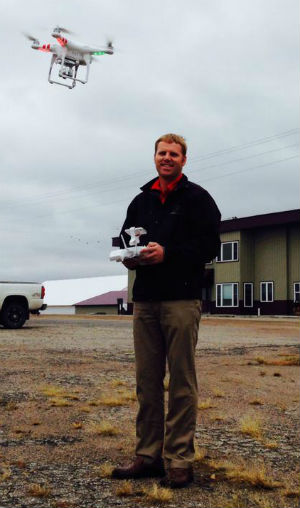What is your first thought when you hear the word drone? If you are like most Americans and follow any sort of mainstream media, your first thoughts probably migrate to the military’s use of these vehicles for surveillance or even running bombing raids in foreign countries. Law enforcement agencies are also beginning to utilize the use of drones in surveillance of rural areas, namely public grounds, in search of illegal operations in the drug trade.
The Unmanned Arial Vehicle’s (or simply UAV as defined by the military) biggest potential in agriculture is the aerial images and data acquisition that can be obtained at a much lower cost than traditional forms that have been utilized in the past. When we look to the future of farming specific to technology, one must always look at what our military is using.
More times than not, the technology that we have to utilize on our farms are a direct descendant of research and development in our military. When the Russians entered space in 1957 with the first satellite, Sputnik I, the space age began. This triggered major investments by the U.S. military in technologies that ushered in a new era of scientific discovery and development. The Global Positioning System (GPS) was developed in the 1970’s, became available to the public in the late 1980’s, and currently is utilized numerous times a day on several different platforms by the American public.
If you were farming in the 1950’s, would it ever have occurred to you that an event such as the Sputnik I would lead to having sub-inch accuracy while planting a field in which the tractor would steer itself?
Drones have come under scrutiny recently in the states by groups such as the American Civil Liberties Union in regards to their use and their possible infringement on people’s privacy. Google’s CEO, Eric Schmidt, has entered the foray in stating that “the use of cheap, miniature, “everyman” drones need to be banned by international treaties before such devices fall into the hands of private users including terrorists.”
Why all the attention on drones? A federal law mandates that the Federal Aviation Administration open up
the national airspace system by 2015. By doing so, it will present the opportunity for people to not only purchase, but to also utilize drones for commercial use. Currently, it is against the law to use or fly a drone as the airspace is controlled by the FAA.
In a study released by the Association for Unmanned Vehicle Systems International (AUVSI), they predict that from 2015 to 2025, the UAV industry could produce up to 100,000 new jobs and add upwards of $80 billion in economic activity. Michael Toscano, CEO of AUVSI, has stated that “eighty percent of utilization of Unmanned Aircraft Systems will be used in precision agriculture.” These are jobs and technology that can be added to the economy while not replacing human capital. While the uses remain limitless, if this technology is utilized and creates simply a 1% increase in output in agriculture in the United States, we are looking at adding billions of dollars into the economy. It is my belief that these tools will lead to more accurate and timely decisions in producing a crop. The level of education and understanding in how to treat a crop is paramount from the air. After all, a bird’s eye view of your fields is the quickest way to see and interpret if you need to take action in your production strategies.
“…a bird’s eye view of your fields is the quickest way to see and interpret if you need to take action in your production strategies.”
Japan has used drones since the early 1990’s in their rice production. Several countries that are our biggest competitors (namely South America) are also utilizing drones for agricultural production. While the technology is here today, we may actually be the laggards in the world community in the utilization of drones. The use of drones has the potential of changing the way we farm. The only thing in the way of their wide spread utilization is the passing of legislature by the federal government in allowing the private industry to use this
technology for widespread adaptation to agricultural production strategies.
 If you’re considering purchasing a drone for your farming operation, please be aware that it needs to be registered. The Federal Aviation Administration (FAA) recently announced that owners are required to register their drones or unmanned aircraft system (UAS) in order to fly them. Below are a few guidelines.
If you’re considering purchasing a drone for your farming operation, please be aware that it needs to be registered. The Federal Aviation Administration (FAA) recently announced that owners are required to register their drones or unmanned aircraft system (UAS) in order to fly them. Below are a few guidelines.



 quickest way to see and interpret if you need to
quickest way to see and interpret if you need to 
